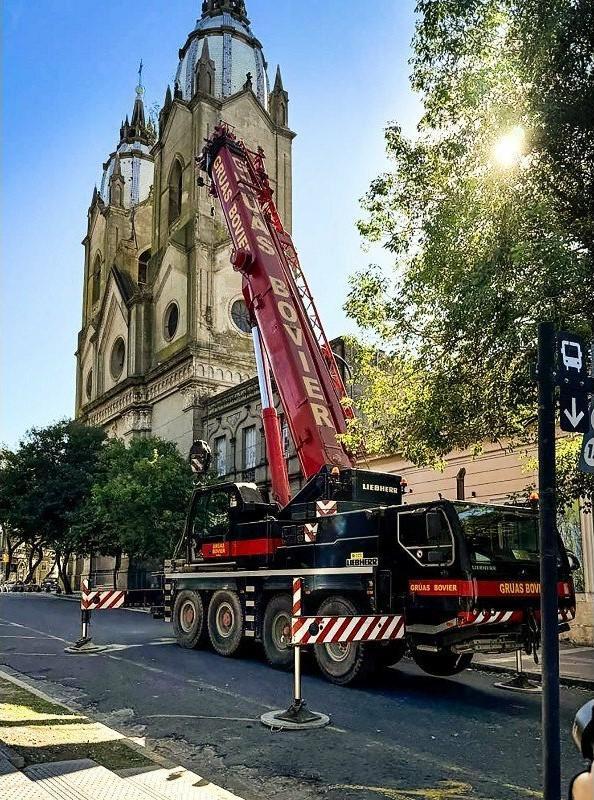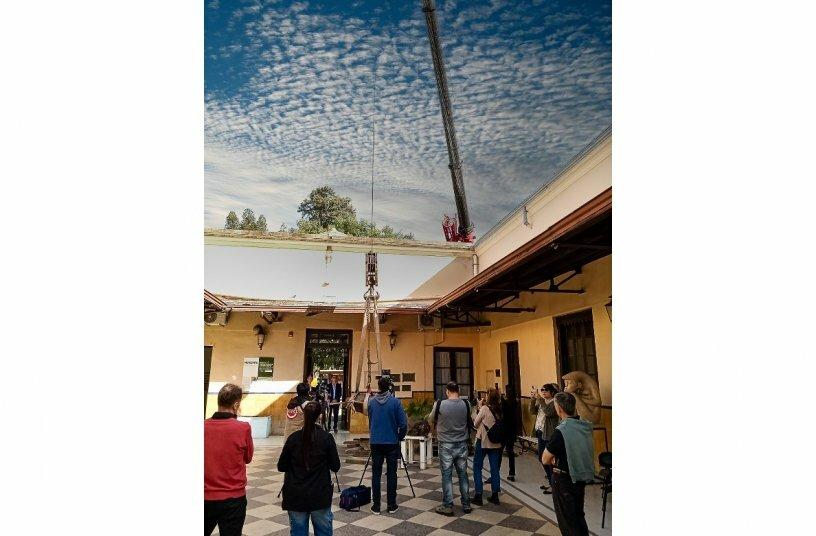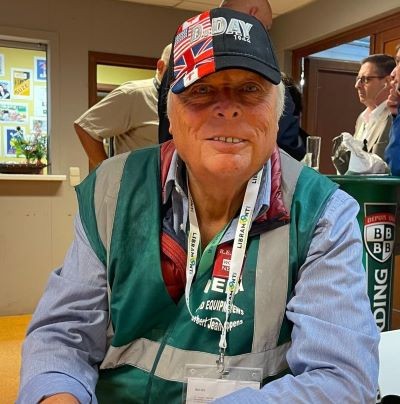R.E.News International-Reaching for the stars – LTM 1060/2 from GRÚAS BOVIER SRL hoists meteorites in Argentina
 24/07/24-FR-English-NL-footer
24/07/24-FR-English-NL-footer
Vers les étoiles – Le LTM 1060/2 de GRÚAS BOVIER SRL hisse des météorites en Argentine

 Argentinian crane contractor GRÚAS BOVIER SRL used an LTM 1060/2 to hoist two meteorites out of a museum in Paraná. IMAGE SOURCE: Liebherr-Werk Ehingen GmbH-After the space rocks had been moved out of the building into the inner courtyard, the LTM 1060/2 lifted them over the roofs of the museum.
Argentinian crane contractor GRÚAS BOVIER SRL used an LTM 1060/2 to hoist two meteorites out of a museum in Paraná. IMAGE SOURCE: Liebherr-Werk Ehingen GmbH-After the space rocks had been moved out of the building into the inner courtyard, the LTM 1060/2 lifted them over the roofs of the museum.
IMAGE SOURCE: Liebherr-Werk Ehingen GmbH
GRÚAS BOVIER SRL a utilisé une grue LTM 1060/2 pour hisser deux météorites du Musée d'histoire naturelle Antonio Serrano à Paraná, en Argentine.
Les météorites, pesant plus de deux tonnes, ont été transportées vers leur site de découverte d'origine dans la province du Chaco.
La configuration de la grue comprenait douze tonnes de ballast et une flèche allongée de 29 mètres pour soulever les météorites au-dessus des toits du musée.
Le travail a nécessité une planification approfondie en raison du statut de bâtiment classé du musée, garantissant l'absence de modifications structurelles.
Les météorites avaient été volées par des passeurs et récupérées par la Gendarmerie Nationale Argentine en 2007 avant d'être placées au musée.
Travaux de grue inhabituels pour le client argentin GRÚAS BOVIER SRL
Le LTM 1060/2 hisse deux météorites hors d'un musée d'histoire naturelle
Un travail passionnant qui a été précédé d'une affaire pénale
L'éventail des travaux de levage que leurs clients demandent aux prestataires de services de grue d'effectuer est très diversifié. L'entreprise argentine GRÚAS BOVIER SRL a réalisé un travail de grue très particulier dans la province d'Entre Rios : au nord de Buenos Aires, deux météorites ont dû être extraites d'un musée et préparées pour le transport.
«Pour être honnête, il ne nous serait jamais venu à l'esprit qu'on nous demanderait un jour de hisser deux roches depuis l'espace», déclare Justo Bovier de GRÚAS BOVIER SRL, qui n'arrive toujours pas à y croire. En juin, lui et son équipe travaillaient au Paraná avec un LTM 1060/2 construit en 2006. Le travail consistait à hisser deux fragments de météorite du Musée d'histoire naturelle Antonio Serrano. "Une fois le travail terminé avec notre grue, ils ont été transportés à l'endroit où ils ont été découverts, dans la province du Chaco, au nord de l'Argentine, à 1 000 kilomètres de notre ville."
Les deux roches spatiales pesaient plus de deux tonnes au total, l'une pesant 1 600 kilogrammes et l'autre 600 kilogrammes. Pour les hisser, la grue à 4 essieux a été installée avec douze tonnes de lest et la flèche de la grue a été rallongée sur une longueur de 29 mètres. Un levage de routine en soi, mais qui nécessitait une planification approfondie à l'avance. En tant que patrimoine culturel et historique de la province d'Entre Rios, le musée est classé monument historique. Le bâtiment, y compris les étages et la cour intérieure, n'a pas pu être modifié pour hisser les météorites : « Notre LTM 1060/2 a donc hissé les fragments de la cour intérieure au-dessus des toits sans qu'ils aient à traverser les différentes salles du musée. » ajoute Bovier. Les travaux, y compris les mesures de sécurité et les fermetures de routes, ont duré plus de deux heures.
GRÚAS BOVIER a été spécialement commandé par les autorités gouvernementales de la province du Chaco. Et l'histoire des météorites n'est pas moins passionnante que le travail actuel de GRÚAS BOVIER. Il y a environ 4 000 ans, des roches pesant plusieurs tonnes sont tombées sur terre et ont atterri au « Campo del Cielo », dans la région de la province de Chaco, dont le nom poétique se traduit par Champ du Ciel, elles ont attiré l'attention des scientifiques et de nombreux touristes. Et ils ont également suscité l’intérêt des passeurs. Ils ont volé les deux météorites pour les revendre au marché noir. Les passeurs ont parcouru environ 1 100 kilomètres avec les pierres, mais ils ne sont jamais parvenus à sortir du pays. Le 23 février 2007, les météorites ont été découvertes lors d'un contrôle routier effectué par la Gendarmerie Nationale Argentine dans la zone de Ceibas, province d'Entre Ríos, qui les a ensuite confiées au Musée des Sciences Naturelles et Antropologiques « Professeur Antonio Serrano » de Paraná. , la capitale provinciale d'Entre Ríos. Donc, tout va bien qui finit bien, les deux roches spatiales étant finalement remises à l’endroit où elles ont été trouvées initialement.
NJC.© Info Liebherr-Werk Ehingen GmbH
-------------------------------------------------------------------------------------------------------------------
 24/07/24-English
24/07/24-English
Reaching for the stars – LTM 1060/2 from GRÚAS BOVIER SRL hoists meteorites in Argentina

 Argentinian crane contractor GRÚAS BOVIER SRL used an LTM 1060/2 to hoist two meteorites out of a museum in Paraná. IMAGE SOURCE: Liebherr-Werk Ehingen GmbH-After the space rocks had been moved out of the building into the inner courtyard, the LTM 1060/2 lifted them over the roofs of the museum.
Argentinian crane contractor GRÚAS BOVIER SRL used an LTM 1060/2 to hoist two meteorites out of a museum in Paraná. IMAGE SOURCE: Liebherr-Werk Ehingen GmbH-After the space rocks had been moved out of the building into the inner courtyard, the LTM 1060/2 lifted them over the roofs of the museum.
IMAGE SOURCE: Liebherr-Werk Ehingen GmbH
GRÚAS BOVIER SRL used an LTM 1060/2 crane to hoist two meteorites from the Antonio Serrano Natural History Museum in Paraná, Argentina.
The meteorites, weighing over two tonnes, were transported back to their original discovery site in Chaco province.
The crane setup included twelve tonnes of ballast and a 29-meter extended boom to lift the meteorites over the museum's roofs.
The job required extensive planning due to the museum's listed building status, ensuring no structural modifications.
The meteorites had been stolen by smugglers and were recovered by the Gendarmería Nacional Argentina in 2007 before being placed in the museum.
Unusual crane job for Argentinian customer GRÚAS BOVIER SRL
LTM 1060/2 hoists two meteorites out of a natural history museum
Exciting job which was preceded by a criminal case
The range of hoisting jobs which crane service providers are asked to do by their customers is quite diverse. Argentinian company GRÚAS BOVIER SRL completed a very special crane job in the province of Entre Rios – to the north of Buenos Aires, two meteorites had to be lifted out of a museum and prepared for transport.
“To be honest, it would never have occurred to us that we would one day be asked to hoist two rocks from outer space,” says Justo Bovier from GRÚAS BOVIER SRL, who still cannot quite believe it. In June, he and his team were working in Paraná with an LTM 1060/2 built in 2006. The job involved hoisting two meteorite fragments from the Antonio Serrano Natural History Museum. “After we had completed the job with our crane, they were taken to the place where they were originally discovered in the northern Argentinian province of Chaco, 1,000 kilometres from our city.”
The two space rocks weighed over two tonnes in total - with one weighing 1,600 kilograms and the other 600 kilograms. To hoist them, the 4-axle crane was set up with twelve tonnes of ballast and the crane boom was extended to a length of 29 metres. A routine hoist in itself, but one that required extensive planning in advance. As the cultural and historical heritage of the province of Entre Rios, the museum is a listed building. The building, including the floors and inner courtyard, could not be modified for hoisting the meteorites: “So our LTM 1060/2 hoisted the fragments from the inner courtyard over the roofs without them having to pass through the various rooms of the museum,” adds Bovier. The work, including safety measures and road closures, took more than two hours.
GRÚAS BOVIER has been specially commissioned by the Chaco provincial government authorities. And the back story of the meteorites is no less exciting than the actual job for GRÚAS BOVIER. Around 4,000 years ago, rocks weighing several tonnes fell to earth and landed in “Campo del Cielo”, in the area of the province of Chaco, whose poetic name translates as Field of the Sky, they caught the attention of scientists and many tourists. And they also attracted the interest of smugglers. They stole the two meteorites to sell them on the black market. The smugglers travelled around 1.100 kilometres with the rocks, but they never made it out of the country. On 23 February 2007, the meteorites were discovered during a traffic control by the Gendarmería Nacional Argentina in the Ceibas area of the province Entre Ríos, who then placed them in the care of the Museo de Ciencias Naturales y Antropológicas “Profesor Antonio Serrano” in Paraná, the provincial capital of Entre Ríos. So, all’s well that ends well, with the two space rocks finally being returned to the place where they were originally found.
NJC.© Info Liebherr-Werk Ehingen GmbH
----------------------------------------------------------------------------------------------------------------
 24/07/24-NL
24/07/24-NL
Reiken naar de sterren – LTM 1060/2 van GRÚAS BOVIER SRL hijst meteorieten in Argentinië

 Argentinian crane contractor GRÚAS BOVIER SRL used an LTM 1060/2 to hoist two meteorites out of a museum in Paraná. IMAGE SOURCE: Liebherr-Werk Ehingen GmbH-After the space rocks had been moved out of the building into the inner courtyard, the LTM 1060/2 lifted them over the roofs of the museum.
Argentinian crane contractor GRÚAS BOVIER SRL used an LTM 1060/2 to hoist two meteorites out of a museum in Paraná. IMAGE SOURCE: Liebherr-Werk Ehingen GmbH-After the space rocks had been moved out of the building into the inner courtyard, the LTM 1060/2 lifted them over the roofs of the museum.
IMAGE SOURCE: Liebherr-Werk Ehingen GmbH
GRÚAS BOVIER SRL gebruikte een LTM 1060/2-kraan om twee meteorieten te hijsen uit het Antonio Serrano Natural History Museum in Paraná, Argentinië.
De meteorieten, die ruim twee ton wogen, werden teruggevoerd naar hun oorspronkelijke ontdekkingslocatie in de provincie Chaco.
De kraanopstelling omvatte twaalf ton ballast en een 29 meter lange giek om de meteorieten over de daken van het museum te tillen.
De klus vereiste een uitgebreide planning vanwege de monumentale status van het museum, waardoor er geen structurele aanpassingen nodig waren.
De meteorieten waren gestolen door smokkelaars en werden in 2007 teruggevonden door de Gendarmería Nacional Argentina voordat ze in het museum werden geplaatst.
Ongebruikelijke kraanklus voor Argentijnse klant GRÚAS BOVIER SRL
LTM 1060/2 hijst twee meteorieten uit een natuurhistorisch museum
Spannende klus waar een strafzaak aan vooraf ging
Het scala aan hijswerkzaamheden waarvoor kraandienstverleners door hun klanten worden gevraagd, is behoorlijk divers. Het Argentijnse bedrijf GRÚAS BOVIER SRL voerde een heel bijzondere kraanklus uit in de provincie Entre Rios – ten noorden van Buenos Aires moesten twee meteorieten uit een museum worden gehesen en klaargemaakt voor transport.
“Eerlijk gezegd zou het nooit bij ons opgekomen zijn dat ons op een dag gevraagd zou worden om twee stenen uit de ruimte te hijsen”, zegt Justo Bovier van GRÚAS BOVIER SRL, die het nog steeds niet helemaal kan geloven. In juni waren hij en zijn team in Paraná aan het werk met een LTM 1060/2 uit 2006. De klus bestond uit het hijsen van twee meteorietfragmenten uit het natuurhistorisch museum Antonio Serrano. “Nadat wij de klus met onze kraan hadden geklaard, zijn ze naar de plek gebracht waar ze oorspronkelijk ontdekt waren in de Noord-Argentijnse provincie Chaco, 1.000 kilometer van onze stad.”
De twee ruimterotsen wogen in totaal meer dan twee ton, waarbij de ene 1.600 kilogram woog en de andere 600 kilogram. Om ze te hijsen werd de 4-assige kraan opgebouwd met twaalf ton ballast en werd de kraangiek uitgeschoven tot een lengte van 29 meter. Op zichzelf een routinetakel, maar wel een die vooraf een uitgebreide planning vergde. Als cultureel en historisch erfgoed van de provincie Entre Rios is het museum een monumentaal pand. Het gebouw, inclusief de vloeren en de binnenplaats, kon niet worden aangepast voor het hijsen van de meteorieten: “Onze LTM 1060/2 hees dus de fragmenten van de binnenplaats over de daken zonder dat ze door de verschillende ruimtes van het museum hoefden te gaan.” vult Bovier aan. De werkzaamheden, inclusief veiligheidsmaatregelen en wegafsluitingen, duurden ruim twee uur.
GRÚAS BOVIER is speciaal gemaakt in opdracht van de provinciale overheid van Chaco. En het achtergrondverhaal van de meteorieten is niet minder spannend dan de daadwerkelijke klus voor GRÚAS BOVIER. Ongeveer 4000 jaar geleden vielen rotsen met een gewicht van enkele tonnen op de aarde en landden in “Campo del Cielo”, in het gebied van de provincie Chaco, waarvan de poëtische naam zich vertaalt als Veld van de Lucht. Ze trokken de aandacht van wetenschappers en veel toeristen. En ze trokken ook de belangstelling van smokkelaars. Ze stalen de twee meteorieten om ze op de zwarte markt te verkopen. De smokkelaars hebben zo'n 1.100 kilometer met de rotsen afgelegd, maar zijn het land nooit uitgekomen. Op 23 februari 2007 werden de meteorieten ontdekt tijdens een verkeerscontrole door de Gendarmería Nacional Argentina in het Ceibas-gebied van de provincie Entre Ríos, die ze vervolgens onder de hoede van het Museo de Ciencias Naturales y Antropológicas “Profesor Antonio Serrano” in Paraná plaatste. , de provinciehoofdstad van Entre Ríos. Het loopt dus allemaal goed af, nu de twee ruimterotsen eindelijk worden teruggebracht naar de plaats waar ze oorspronkelijk werden gevonden.
NJC.© Info Liebherr-Werk Ehingen GmbH
--------------------------------------------------------------------------------------------------------------
Date de dernière mise à jour : 23/07/2024

















